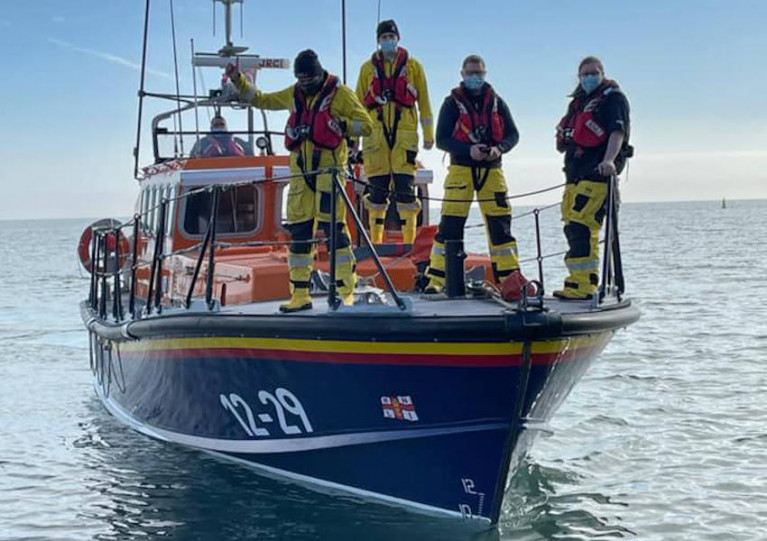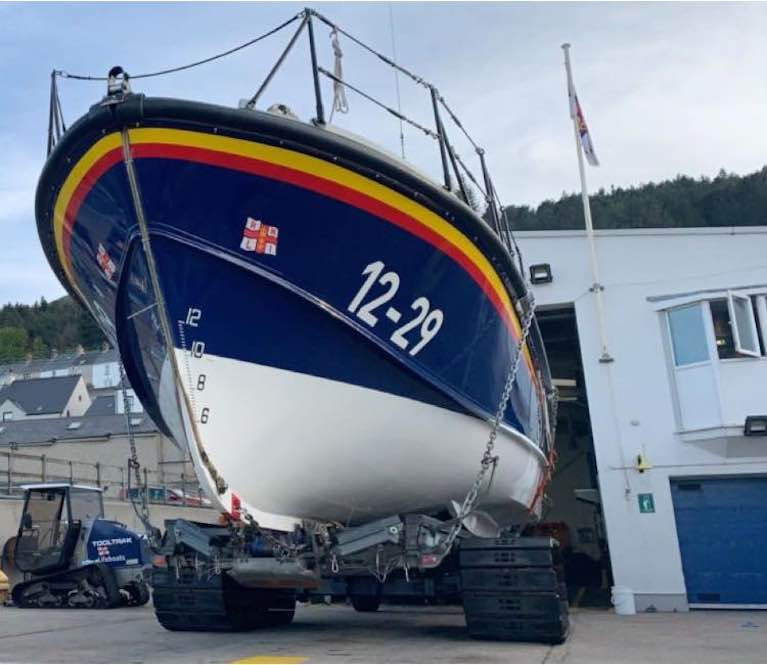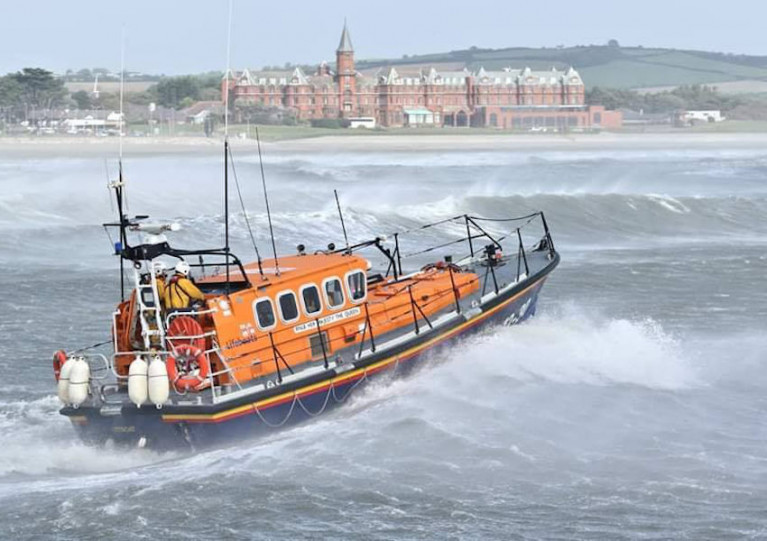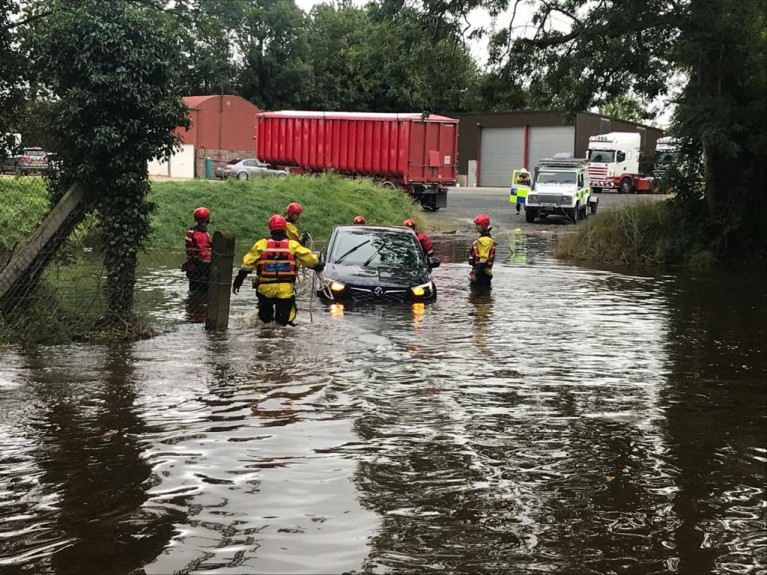Displaying items by tag: Newcastle
Newcastle Lifeboat Volunteers Rescue Swimmer From Rough Seas
Volunteers at Newcastle RNLI rescued a swimmer who got into difficulty in rough seas close to the Co Down harbour this morning (Wednesday 2 March).
Two volunteers and three visiting staff members were working at the lifeboat station when shortly after 11am they observed a swimmer clinging to a buoy off the slip, having struggled in rough seas, and immediately went to their aid.
Station mechanic Shane Rice, under the watchful eye of the four others, grabbed a throw line and threw it to the swimmer who was able to reach it and hold on as the group successfully pulled them out of the water and brought them safely onto shore.
Weather conditions at the time were poor, with an easterly Force 6 wind and moderate waves.
Speaking following the rescue, Newcastle RNLI lifeboat operations manager Lisa Ramsden said: “This morning’s rescue was testament to our team who were in the right place at the right time, reacting quickly and efficiently, and I want to commend them for responding with courage and determination when they spotted the person in difficulty. We would like to wish the swimmer well following their experience this morning.”
She added: “Open water swimming is a popular activity, and we would encourage all swimmers to enjoy their swim while using some key safety advice.
“Check weather forecast and tide times before venturing out. Always carry a means of calling for help and let someone on the shore know where you are going and when you are due back. If you can, try to avoid swimming alone — consider going with a buddy or as part of a group and look out for one another.
“Make sure you have the right kit. We would recommend a wetsuit in order to keep you warm and to increase your buoyancy together with a bright swim cap to make you more visible and a tow float to use in an emergency.”
New Mersey Class Lifeboat Goes on Service at Newcastle RNLI
When it retired from active service at Margate on England’s southeast coast in April last year, the Mersey class all-weather lifeboat faced an uncertain future but RNLB Leonard Kent has now arrived at its new home at Newcastle in County Down where it will continue its lifesaving work.
Leonard Kent initially spent some time at the RNLI Support Centre at Poole but was considered worthy of further service and subsequently earmarked to replace Newcastle’s existing Mersey class lifeboat from where it will operate until building work at the station has been completed and their new Shannon class all-weather lifeboat arrives.
Leonard Kent was moved to a boatyard at West Cowes on the Isle of Wight and treated to a life-extension programme including upgrading the electronics to the latest Systems and Information Management System (SIMS). Leonard Kent would have been familiar with its surroundings having been built at the then FBM Marine shipyard at Cowes in1992.
 Training on the new upgraded Systems and Information Management System was carried out while the lifeboat was on passage from Dun Laoghaire to Newcastle this week
Training on the new upgraded Systems and Information Management System was carried out while the lifeboat was on passage from Dun Laoghaire to Newcastle this week
On receiving the new lifeboat to Newcastle RNLI this week, Lifeboat Operations Manager Lisa Ramsden said: ‘It is with a sense of nostalgia that we bid farewell to our outgoing all-weather lifeboat, the Eleanor and Bryant Girling, which served the Newcastle community and all those whose aid she went to, for almost 30 years. As we begin a new chapter, we are looking forward to being the custodians of the Leonard Kent and the volunteer crew are excited to now have an upgraded Mersey.
‘Training on the new upgraded Systems and Information Management System was carried out while the lifeboat was on passage from Dun Laoghaire to Newcastle this week. The removal of the original radar and navigation system from the Mersey helps to reduce weight and create more space in the wheelhouse while an additional benefit for us here in Newcastle RNLI is that the new system will ensure the volunteer crew are prepared and proficient in the radar and navigation systems that will come with our future Shannon class lifeboat.’
Portaferry & Newcastle Lifeboats Launch to Sinking Cabin Cruiser
Lifeboat crews from Portaferry and Newcastle RNLI were involved in the rescue of a man whose cabin cruiser was in danger of sinking off Co Down yesterday (Thursday 16 September).
The volunteers were requested to launch their lifeboats at 6pm yesterday evening following a request from Belfast Coastguard to go the aid of the casualty, who had abandoned his 9m cabin cruiser and had been rescued by the crew of a nearby motorboat.
Portaferry RNLI’s inshore lifeboat — helmed by Fergal Glynn and with crew members George Toma, Rosslyn Watret and David Fisher onboard — launched immediately and made its way to the scene one mile east of Gunn’s Island, southeast of the entrance to Strangford Lough on Northern Ireland’s east coast.
Newcastle RNLI, meanwhile, launched its all-weather lifeboat under coxswain Gerry McConkey and six crew members onboard, facing Force 4-5 southerly winds and a two- to two-and-a-half-metre sea swell.
Once on scene, the lifeboat crews saw that the casualty — who had been on his way to Bangor when his vessel took on water and the engine cut out — had deployed his life raft prior to his rescue.
The crews also observed that the cruiser was partially submerged, was listing and in a spin.
Having first checked that the casualty was safe and well on the motorboat, Portaferry RNLI transferred him onto the lifeboat before doing a further assessment. The man was cold and in shock but otherwise well.
The crew took the life raft onboard and deflated it before bringing the casualty to the nearest safe port at Ardglass, where they transferred the casualty into the care of Portaferry Coastguard.
Remaining at the scene, Newcastle RNLI proceeded to deal with the casualty vessel, with some crew working to establish an alongside tow while other crew members started the lifeboat’s salvage pump.
Due to the sea conditions, a decision was made to keep the pump onboard the lifeboat and instead pass the hose onto the boat to relieve the ingress of water.
In calmer waters and in the entrance of Strangford Lough, two crew members were transferred onto the vessel to assess the extent of the flooding. The lifeboat then proceeded to tow the vessel safely back to Strangford Lough.
Speaking following the callout, Portaferry RNLI helm Fergal Glynn said: “We would like to wish the casualty well following his ordeal yesterday evening and commend the crew of the motorboat who were first on scene and rescued him.
“This operation was a team effort with our colleagues from Newcastle RNLI and Portaferry Coastguard all playing their part to bring both the man and the vessel to safety.”
Four Callouts in Busy Friday For Newcastle Lifeboat Crew
Newcastle RNLI in Northern Ireland had a busy Friday (16 July) with four callouts within a span of 20 hours.
The volunteer crew were first requested to launch their inshore lifeboat at 2.36am on Friday morning to assist two men on a small boat which had broken down after experiencing difficulties off the Co Down coast. The vessel was towed back to its mooring at Newcastle Harbour.
At 12.40pm on Friday, the station’s all-weather lifeboat crew were requested by Belfast Coastguard to conduct a search after a number of personal possessions, including a swimmer’s robe, were discovered a short distance from the lifeboat station.
Shortly after the lifeboat was launched, it was stood down when it was ascertained the items had been on the rocks for several days.
Later at 6.53pm, both the inshore and all-weather lifeboats were requested to launch following a report to Belfast Coastguard from a member of the public that they had lost sight of a man that had entered the water after his dog at Murlough Beach in the Dundrum area.
As the lifeboats were about to launch, they were stood down as the man had managed to make it ashore.
At 9.14pm on Friday, both lifeboats were again requested to launch following a report that a parachutist had lost control and crashed into the water, south of Newcastle Harbour.
Extensive searches were carried out, with assistance from a coastguard helicopter from Wales, as well as local coastguard teams. During the search, lifeboat crew spotted a large deflated helium balloon which was retrieved from the sea. The search was subsequently stood down.
Speaking following the callouts, Newcastle RNLI lifeboat operations manager Lisa Ramsden said: “It has been a busy period for the station and I would like to commend our volunteer team and our colleagues in the various emergency services for their efforts.
“Some of these callouts transpired to be false alarms with good intent and we want to thank those who raised the alarm. We would always much rather launch and find that all is well than not launch at all.
“As we continue to enjoy some glorious weather, we would like to remind everyone to enjoy themselves but to always respect the water as they do. Always wear a lifejacket or personal flotation device and always carry a means of communication.
“Always let someone on the shore know where you are going and when you are due back and should you get into difficulty or see someone else in trouble, dial 999 or 112 and ask for the coastguard.”
Newcastle RNLI Lifeboat Assists Kayakers in Dundrum Bay
Newcastle RNLI volunteer crew launched the inshore D class lifeboat 'Eliza' at the request of Belfast Coastguard to assist three kayakers who were in difficulties in Dundrum Inner Bay yesterday morning. The bay lies on the south County Down coast about 6km east of Newcastle.
The Inner Bay is almost landlocked and separated by the dune systems of Ballykinler to the north and Murlough to the south.
The kayakers, a mother, her daughter, and a friend, had launched their kayaks at the slipway opposite Dundrum chapel in the Main Street, on a falling tide and paddled towards the channel between Murlough Nature Reserve and Ballykinler Army Camp.
 Dundrum Inner Bay is almost landlocked and separated by the dune systems of Ballykinler to the north and Murlough to the south
Dundrum Inner Bay is almost landlocked and separated by the dune systems of Ballykinler to the north and Murlough to the south
With the tide surging out of the Inner Bay and towards the open sea, the three kayaks were swept towards the bar mouth. Conditions were rough at the time and the group were hailed on a tannoy by Range Controllers who saw them from the nearby army camp and who advised them to turn around. With the three kayakers caught in the grip of the tide, one of them managed to call Belfast Coastguard who immediately tasked Newcastle RNLI inshore lifeboat and Newcastle Coastguard team to the scene.
Newcastle RNLI Coxswain, Niall McMurray, said, "Thankfully when we arrived on scene one of the kayakers had managed to make shore on the Murlough side of the channel while the other two had made shore on the Ballykinler side".
Two of the kayakers had capsized and spent some time in the water before making it ashore. The Range Controllers took care of the two people in Ballykinler while the Coastguards from Newcastle picked up the third on Murlough beach and took her to the army camp to be reunited with her group.
"We retrieved the kayaks from the water and returned to station" said Niall McMurray.
"All three kayakers were well equipped with lifejackets, radios and mobile phones but unfortunately got caught out by the strength of a surging tide which swept them towards the bar mouth which was rough because of the south wind".
The RNLI would advise all kayakers to always carry a means of calling for help and have it stored in an easy to reach location in case of emergency. Also, consider taking a mobile phone with the SafeTrx app.
The volunteer crew at Newcastle RNLI in Co Down returned to sea recently after normal training exercises had to be curtailed due to Covid-19.
While the station has remained fully operational throughout the pandemic and volunteers have remained on call 24/7, training has been limited for Northern Ireland’s RNLI crews.
The crew took their first training session in daylight hours in Dundrum Bay while the second exercise was at night. The volunteers all wore the necessary COVID-19 PPE as well as their usual seagoing suits and lifejackets during the training.
The Mersey class all-weather lifeboat Eleanor and Bryant Girling was given a timely workout on both occasions, which provided an opportunity for the crew members to put their training and lifesaving skills into practice.
Speaking following the exercises, Newcastle RNLI coxswain Nathan Leneghan said: “Maintaining our lifesaving service while keeping our people safe continues to be the RNLI’s main priority.
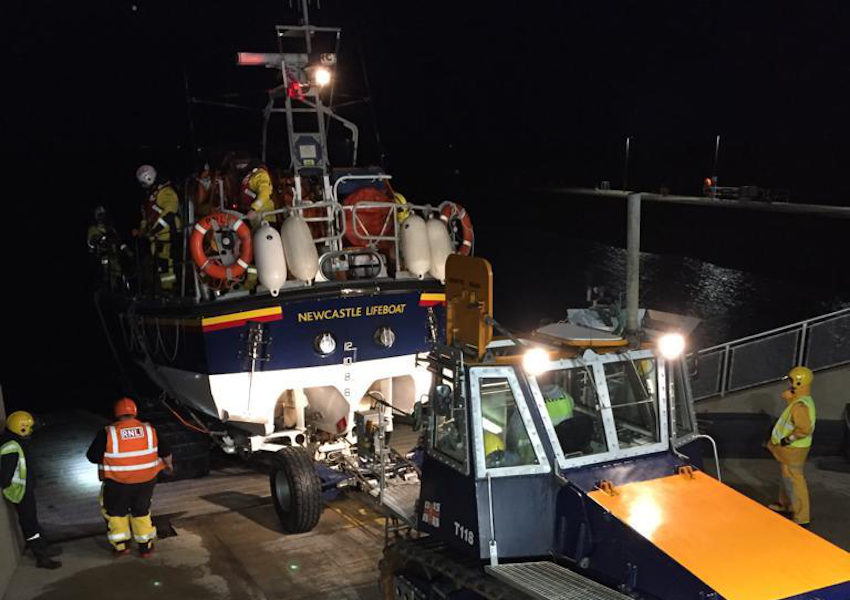
“Exercises form an important part of our work, allowing our lifeboat crews to maintain their skills and ensure they are always prepared for what they face out at sea.
“In the daylight exercise, we went on a local area knowledge exercise and mechanical shakedown to trial all the systems, ensuring they are ready when required. It was a glorious morning and a great opportunity to return to exercise.”
Newcastle RNLI’s second coxswain Niall McMurray added: “During the night-time exercise, the crew covered some mechanical engine tests after which we went on to focus on emergency procedures.
“We ran through all the alarms on the lifeboat to reacquaint ourselves with the different sounds and how to react if they were activated in a real-life situation. We practised a fire drill and how to deal with a fire in each area of the lifeboat.
“We then went on to test our flares which are primarily used to light up an area at night before concluding the evening learning how to rig and operate the emergency steering.”
Newcastle Lifeboat's First Shout of 2021 as Teenage Girls Cut Off by the Tide on Murlough Beach
The first shout of 2021 for the Newcastle RNLI Inshore Lifeboat was a call out from Belfast Coastguard just before 3 pm today to reports of two teenage girls cut off by the tide on Murlough Beach.
The beach is a four-mile stretch just east of Newcastle town on Dundrum Bay in the south of Co Down and is owned by the National Trust.
The Inshore D class lifeboat "Eliza" arrived on scene soon afterwards and commenced a shoreline search. Due to surf size, the All-weather Mersey class Lifeboat, Eleanor, and Bryant Girling were also requested to launch and assist with a higher platform for visibility.
But as the crew were preparing to launch the ALB a further page from Belfast Coastguard at 3.15 pm cancelled the launch as both girls had been safely located by parents and were leaving the area.
RNLI Newcastle locates Missing Swimmer in Dundrum Bay (Updated)
Just three days after the return of Newcastle RNLI station's D class lifeboat, Eliza, after a refit, in the late afternoon yesterday, Belfast Coastguard requested the immediate launch of the both the station's Lifeboats to reports of an overdue swimmer in the vicinity of the Inner Dundrum Bay area at at Murlough Beach.
The swimmer had got separated from his friend. Coastguard teams from Newcastle, Kilkeel and Portaferry, police officers from Newcastle and Downpatrick and the Coastguard helicopter from Valley, in Wales were also involved in the search.
Dundrum Outer Bay lies east of Newcastle in south County Down. The Outer Bay is a wide gently shelving bay, and the Inner Bay is an estuarine lagoon, connected to the Outer Bay by a tidal channel.
The search extended from Murlough Beach, around Dundrum inner bay to Tyrella Beach in difficult conditions with a strong, cold onshore wind.
Over two hours after he went missing the swimmer was found by Police Officers on the beach at Ballykinler Army Base, having been swept away from Murlough and across the bay before coming ashore. The man was taken to hospital.
The rescue was coordinated by Belfast Coastguard Operations Centre.
This story was updated on November 17 with up to date details of the rescue operation
Newcastle RNLI Seeks New Volunteer Lifeboat Press Officer
The team at Newcastle RNLI in Northern Ireland is calling for a new volunteer lifeboat press officer to help them to save lives at sea.
This role will help raise awareness of the RNLI through the promotion of the lifeboat station’s vital work, including newsworthy rescues carried out by the crew.
Newcastle RNLI is seeking someone who can produce and distribute regular new releases, be available to answer media enquiries, work to support media opportunities and facilitate interview requests.
The role is best suited to someone with good writing and communication skills, who lives locally and can be flexible with their time.
Lisa Ramsden, Newcastle RNLI’s lifeboat operations manager, said: “Volunteering with us gives people the opportunity to make a real difference in their local community, to save lives and become part of the larger RNLI family.
“We can’t keep people safe without the support of our wonderful volunteers, who truly make a difference every day no matter which role they are fulfilling.
“Becoming a volunteer lifeboat press officer is a great chance to play a crucial part in helping to save lives.
“We’re looking for an enthusiastic person with good writing and interpersonal skills and who enjoys working with people and at times under pressure to inform the media and update our community on the various lifesaving activities that are happening at the station from rescues to fundraising, community safety to events.”
Anyone interested in finding out more or wants to apply should follow the link to the RNLI website HERE.
Newcastle Community Begins Clean-Up As Storm Francis Flooding Leaves Co Down Seaside Town ’A Disaster Zone’
Clean-up operations are under way in Newcastle and other parts of Co Down after the Shinma River burst its banks due to heavy rainfall from Storm Francis yesterday (Tuesday 25 August).
As BreakingNews.ie reports, as many as 300 homes were affected by the floodwaters which rose over one metre in some areas.
South Down MLA Colin McGrath said of the scene: “It is like a disaster zone.”
Respect to the lads from the Rivers Agency who are working in difficult conditions into the night in Newcastle to prevent flooding of nearby homes. pic.twitter.com/lnKygGfWOj
— Kevin Sharkey Pull Together - Stay Apart. (@tv_KevinSharkey) August 25, 2020
Flooding was particularly acute in the Bryansford Avenue area of Newcastle, along the north side of the Shinma River at the foot of the Mournes.
The Northern Ireland Fire and Rescue Service said a number of people were rescued from their homes as a specialist rescue team, flood response teams and local crews attended the situation.
Between midnight & 5pm today we have attended 28 flooding incidents across the Newcastle, Maghera, Draperstown & Cookstown areas. Working in challenging conditions, Firefighters, with the support of other agencies, rescued 37 people from flood water. #NotjustFires #SaferTogether pic.twitter.com/i5mXaPDwKC
— Northern Ireland Fire & Rescue Service (@NIFRSOFFICIAL) August 25, 2020
Dozens of homes and businesses in Co Cork were also damaged by flooding and strong winds as the storm blew through the county early yesterday. The Irish Times has more on the story HERE.



























